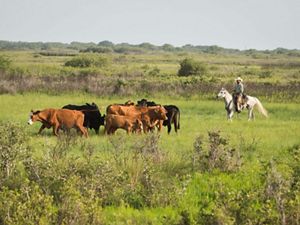Big Bend National Park
In the 1980s, The Nature Conservancy helped transfer 57,000 acres in the Rosillos Mountains to expand one of Texas' most treasured national parks.
The Nature Conservancy (TNC) was thinking big during the 1980s—and in Texas, it doesn't get any bigger than Big Bend National Park. Specifically, TNC sought to add the North Rosillos Mountain Ranch in Brewster County, also known as Harte Ranch, to the national park, protecting the property in perpetuity.
At the time, Big Bend was already a Texas-sized park, sprawling across more than 700,000 acres of remote West Texas terrain. Its protected lands boast awe-inspiring geological features, ranging from cliffs that separate Cedar Creek from the lowlands and springs at the base of the mountains to flat expanses such as Chalk Draw and Nine Point Draw.

Most notably, its ecological features include 118 miles of the Rio Grande running like a blue ribbon through deep canyons and the Chisos Mountains, which jut out more than a mile high from an arid plain to form a sky island forested with pinyon pine, juniper, mountain mahogany and Texas madrone trees. The surrounding area is dominated by a vast expanse of Chihuahuan Desert filled with plants like lechuguilla, sotol, yucca, prickly pear and mesquite that are capable of surviving in a hot, dry environment.
A survey of mammals conducted at the Harte Ranch area in 2006 revealed that 42 species—about 60% of the mammals found elsewhere in the park—could be found here. Among recent wildlife sightings in this eastern part of the Trans-Pecos are occasional mule deer, pronghorn antelope, black-tailed jackrabbits and collared peccary. Birds such as the greater roadrunner, peregrine falcon and black-throated sparrow have also been spotted from the road that runs along the addition's eastern edge.


Uncovering the Region's History
In the early 1980s, the Office of the State Archeologist conducted an assessment of the remote Rosillos Mountains, uncovering the site's hidden historical significance. A more detailed assessment of Rosillo Peak carried out by Sul Ross State University archeologists in 2005 found that hunter-gatherers likely visited the crest for some 5,000 years. In combination, the two investigations identified nearly 5,000 artifacts in the mountains, including 221 tools and tool fragments from visits as early as 3,500 B.C.
The artifacts at windswept Rosillo Peak, whose upper slopes are littered with weathered boulders, indicate that the site lacked some signs of daily living use. Combined with the presence of some small, potentially ritualistic arrowheads, the peak's location far above any springs suggests that it may have served a sacred purpose.

Expanding a Legacy of Lonestar Land
Most people would assume that the park would be eager to absorb more acreage—but that wasn’t the case, according to Jeff Weigel, TNC’s director of strategic initiatives in Texas.
By the 1980s, TNC already had a solid record of working with landowners and public agencies to protect large swaths of Texas land. This ranch, however, represented an acquisition of unprecedented size.
“It was the single biggest piece of land TNC had ever owned in Texas,” Weigel said. “At the time, we just didn’t have the resources to manage it. So, getting it added to the park was our goal from the start.”


The ranch was owned by Ed and Houston Harte, the scions of a prominent Texas family who were well-known for their philanthropy and interest in conservation.
“They had already tried to donate the ranch to the National Park Service but had hit a bureaucratic wall. That’s when they contacted us to see if we would accept the ranch and take up their cause,” said Weigel.

Soon after accepting the 67,000-acre ranch in 1985, TNC learned that expanding the boundaries of a national park required an act of Congress—literally. That, in turn, required getting the support of Texas lawmakers. After a winding, three-year congressional process, the National Park Service incorporated 57,000 acres of the North Rosillos Mountain Ranch into Big Bend National Park. TNC sold the remaining 10,000 acres to a private individual, and several years later, the National Park Service purchased that parcel, too.
Today, TNC remains just as dedicated to helping expand public lands, a commitment on display at iconic Big Bend and around the great state of Texas. In total, TNC has played a critical role in preserving 34 of Texas’ state and national parks—spaces which people across the state continue to explore and enjoy today.
We Can’t Save Nature Without You
Sign up to receive monthly conservation news and updates from Texas. Get a preview of Texas' Nature News email.




